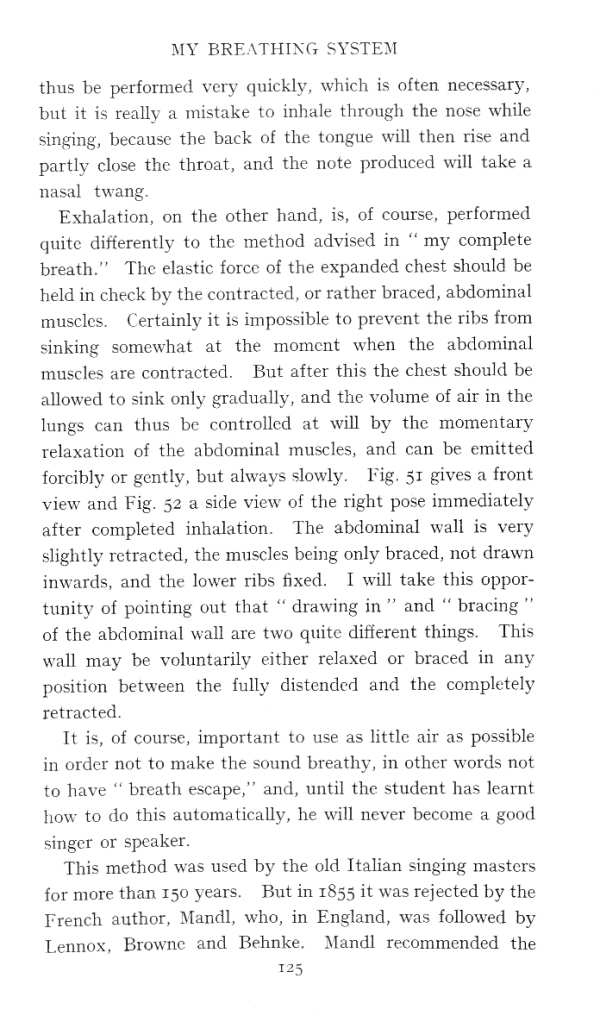mbs 125

MY BRFATHING SYSTEM
thus be performed vcry quickly, which is often necessaiy, but it is really a mistake to inhale through the nose while singing, becausc tbe back of the tongue will then rise and partly close the throat, and the notę produced will take a nasal twang.
Exhalation, on the other hand, is, of course, performed quitc differently to the method advised in " my complete breath.'' The elastic forcc of the expanded chest should be held in check by the contracted, or rather braced, abdominal musclcs. Certainly it is impossible to prevent the ribs from sinking somewhat at the moment when the abdominal muscles are contracted. But after this the chcst should be allowed to sink only gradually, and the volume of air in the lungs can thus bc controllcd at will by the momentary relaxation of the abdominal muscles, and can be emitted forcibly or gcntly, but always slowly. Fig. 51 gives a front view and Fig. 52 a side view of the right pose immediately after completed inhalation. The abdominal wali is verv slightly rctracted, the muscles being only braced, not drawn inwards, and the lower ribs tixed. 1 will take this oppor-tunity of pointing out that “ drawing in ” and " bracing " of the abdominal wali are two quitc ditferent things. This wali may be voluntarilv either relaxed or braced in any position between the fully distended and the completely retracted.
It is, of course, important to use as littlc air as possible in order not to make the sound breathy, in other words not to have " breath escape,” and, until the student has learnt how to do this automatically, he will never become a good singer or speaker.
This method was used by the old Italian singing masters for morę than 150 years. But in 1855 it was rejected by the French author, Mandl, who, in England, was followed by Lennox, Brownc and Behnke. Mandl recommcnded the
125
Wyszukiwarka
Podobne podstrony:
42383 mbs 020 MY BREATHING SYSTEM always be performed rather slowly. Referencc to “ Y Tv System ” wi
75732 mbs 060 MY BREATHING SYSTEM are widened. The completeness of inhalation is surę to be frustrat
mbs 044 MY UKliATHING SYSTEM can be eleualed and thc diaphragm depressed at one and the same limę. T
88282 mbs 057 MY BRFATHING SYSTEM widening of the thorax resembles, to some extent, the move-ments o
mbs 076 MY BRKATHING SYSTEM in the tuition of all tcchiiical points of a gamę, but they very, verv s
52396 mbs 043 MY BREATHING SYSTEM when we spend our time in crowded halls in poisonous air, or are f
więcej podobnych podstron